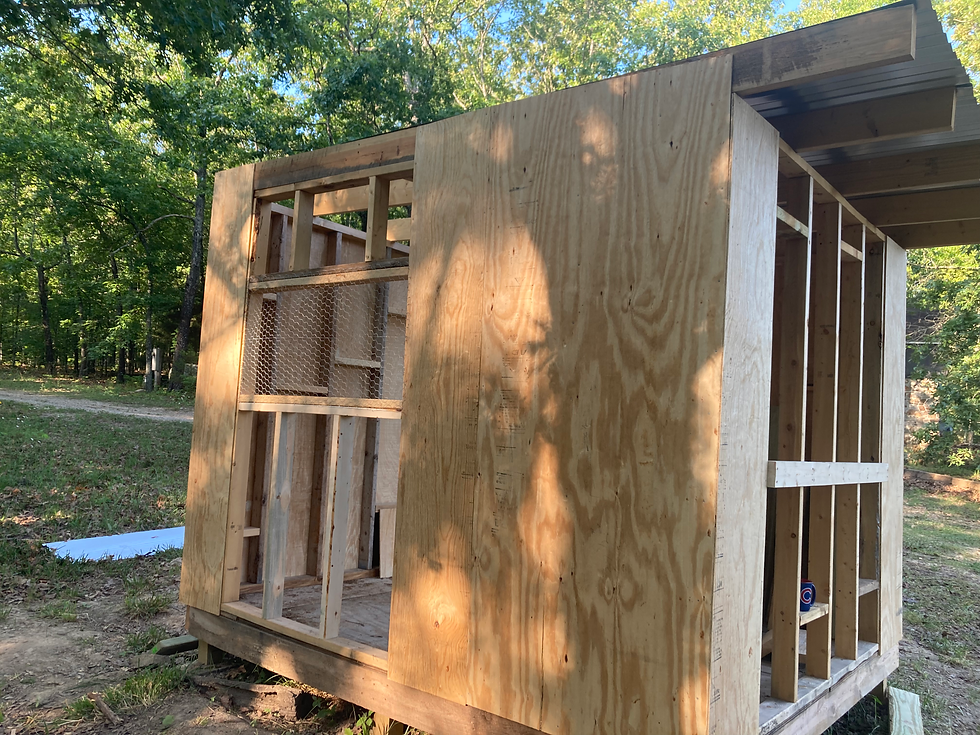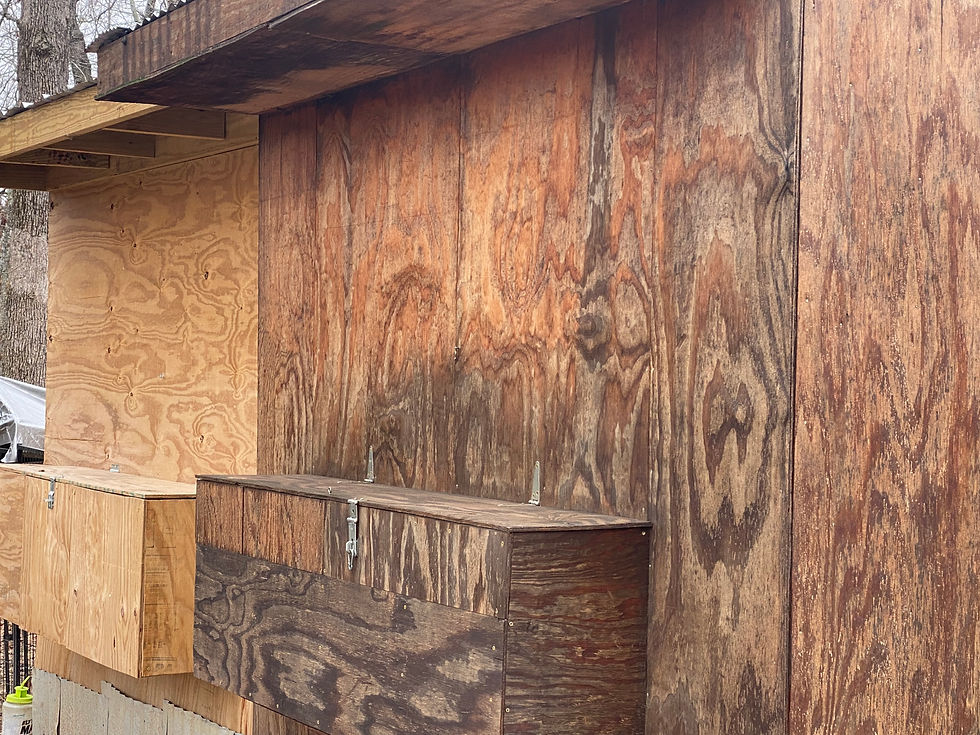Chickens, Chickens and more Chickens
- 27kevinborst
- Jun 8
- 5 min read
The first livestock on the property were chickens. They seemed like they were the best fit for someone who had never owned livestock and was going to be working full time, while trying to have some home grown food on the property. The first thing I will say is when I decided to get chickens everyone that found out wanted to give me their advice about how to do things, the coop to build, what chickens to get, etc. I appreciated the advice and input but something that is not often said is what works for someone else may not work for you.
This can be countless reasons, different seasonal weather, the adaptation of the breed to your property, and just different breeds and how they respond to the set-up you provide them. I had to learn as I went and had tons of mistakes but also some great rewards once I started paying attention to what the chickens were saying. (Yes, if you pay attention to your hens they will start to tell you what is wrong). For example, if you give them treats the clucking sound they make shows their excitement and normally a larger amount of eggs the following evening is sure to follow. We love to give them meat scraps, watermelon and veggies.
Before buying hens I decided to build the coop you will see below. I had never done anything like this so I was making it up as I went. Over half the material you see was salvaged and reused to save money. I wanted a coop that I could easily go into and clean, work on or just be around my chickens. I also wanted nesting boxes on the outside of the coop so I did not always have to go in and disturb the ladies... they do not always appreciate you poking about. One of my ideas was to build an over hang over the nesting boxes to offer them some protection from the rain. This in theory is a good idea but my mistake was I did not extend the overhand far enough so the egg grabber aka me gets rained on while grabbing eggs. Also, I slanted the roof to the nesting box side which looking back I have no clue what I was thinking when doing that other then that was the way the water drains on my property. Looking back I would have moved the boxes to a different side. You will notice that in the later photos that there is an addition attached. A piece of advice I found to be true was plan on having more chickens then you planned. This could not have been more true within the short amount of time owning chickens. I built a coop to start that was 9x9 and within a year had to add an addition of 9x8 to accommodate the growing flock.
I started with 13 chickens (2 roosters and 11 hens). The original build of the coop worked great. After they spent a month in my bathtub (yes, I used a bathtub as a brooder) I moved them into the coop which they enjoyed the space and spent another month in the coop before I let them outside. I like to keep my chickens in the coop for the first month so they know where home is. I found this helps when free ranging they tend to head for the coop like clockwork right at sundown. It also helps the ladies lay in the nesting box right away so I am not easter egg hunting for my eggs. The first year went very well and when they started laying I could not be happier with gathering anywhere from 7-11 eggs a day. For someone that eats a minimum of 3 eggs a day this is quite a savings in the long run from having to buy eggs from the store. With my chickens I had a few issues mainly with a few dying. After the first year, I did have one rooster whose name was Hank die because of heat exhaustion and his refusal to give the ladies a break on a 100 degree day. I am not kidding when I say I watched him walk into the woods, flap his wings, gasp and then simply fall over dead. I also had a hen die from being egg bound. I did not realize what was happening before it was too late. By the time I got up in the morning I saw she was in serious discomfort. I tried to separate her and give her some water but before I could research what was going on she passed on.
After losing the two chickens I had a decision to make, continue with my clutch of chickens, purchase more or try hatching my own. I decided on the later and with much success I started 15 eggs and had 13 hatch on my first round. The second I had 15 eggs again 13 hatched and 2 died early. Leaving me with a total of 24 new chickens. This time they were no longer put in the bathtub (I remodeled my bathroom and had no more tub). Instead I built a small brooder and had them on the table for the first week. The first week I enjoy having them in the house. Their chirps bring the house to life and it is before they start to get smelly. At week 2 they go out to the coop into a brooder that I built inside the coop which has come in handy when hatching multiple rounds of chicks. After hatching these chicks I was gifted another 30 chickens. So remember that first number of 13? I went from that to well over 50 chickens in less then 2 months. This is where the second coop came into play and I had to have an addition to fit everyone. When building the addition I made it possible to separate the coops if needed with a door. Along with this I created 3 separate runs that can all be accessed from chicken doors or shut off if needed. This allows me to separate hens or roosters if I need to while still allowing the chickens to access the coop and all the runs.
Of the newest clutch of chicks I had over 15 roosters which is way to many for one coop and that many ladies. So I decided to use the 15 roosters for meat. The other issue was they began terrorizing the hens and I could barely get 2 eggs a day out of them. Now no eggs and terrorizing my ladies, there is only one viable option the roosters wind up on my dinner plate. They were not relatively big birds as the timing of slaughtering them was quickened due to their constant harassment of the hens, but they were still good eating.
This made me decide to try my hand at breeding chickens for meat this year. They are still growing and about a month from the point of slaughtering. I will have to share how they turn out. Also, will show how we use a chicken tractor to separate the bigger meat hens from the smaller chicks to avoid too much bullying while also using them to graze and fertilize certain areas of the property.
We decided to double our flock once again and expand our operation to selling chicks, eggs and possibly meat in the future. The chickens are a constant learning process and we are growing what we do with them on a regular basis. At times we may share some things that work for us and our flock, but at the end of the day what works for you is going to be dictated by your flock, property and the needs of your family.








Comments